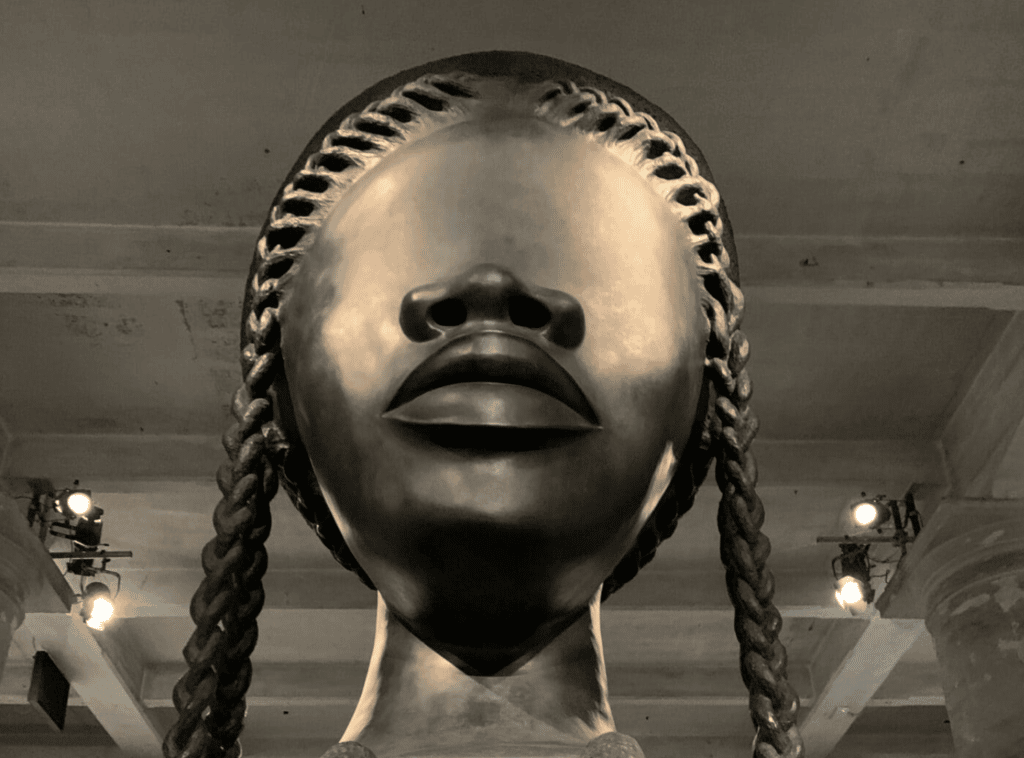Orange Collective
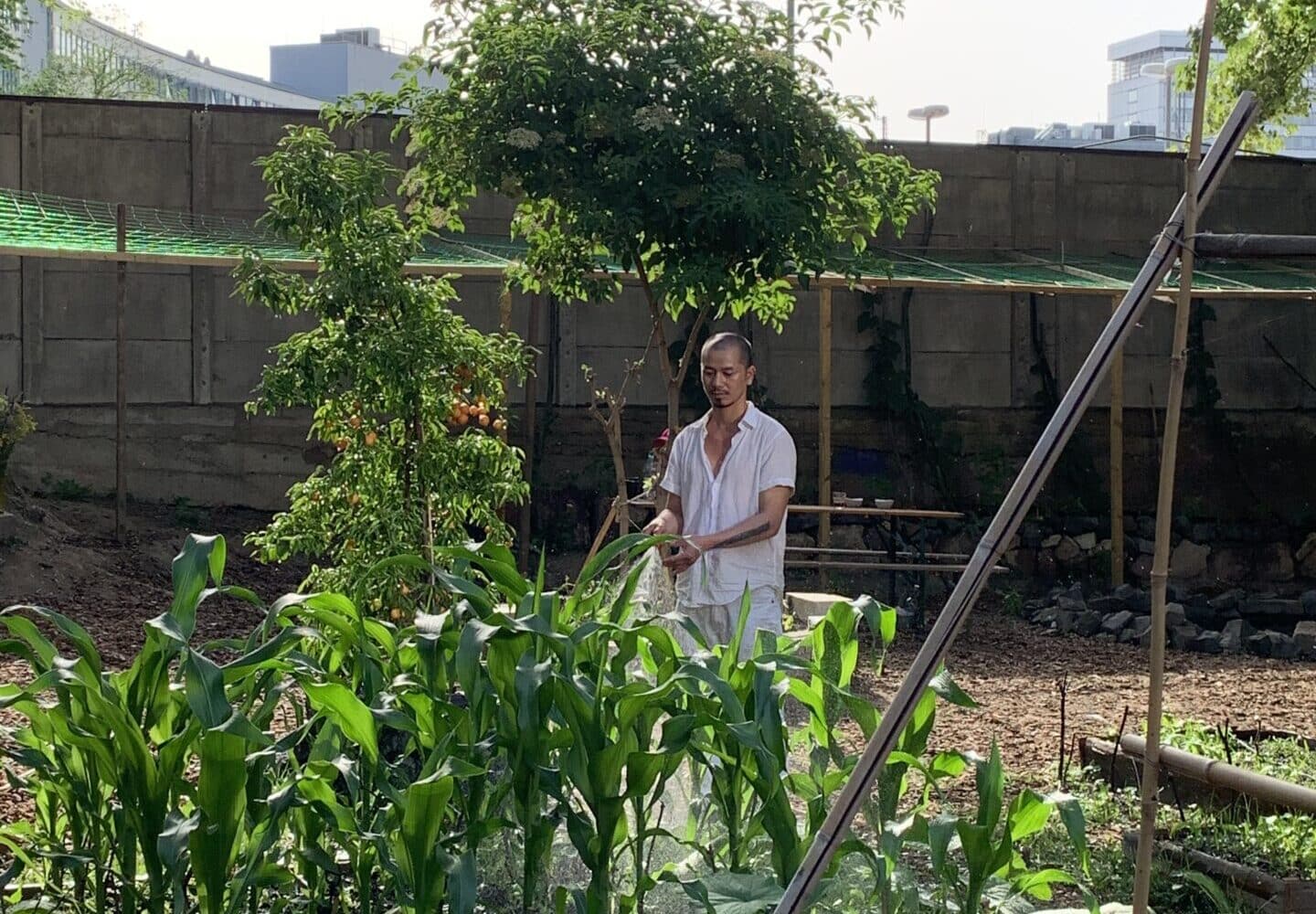
Report on the Venice Biennale 2022 and Documenta Fifteen for the Orange/Mikan Collective (Final)
Kinan Art Week Yabumoto Yuto
Following Part 1, Part2 of this report, I will discuss what we should make use of for the Mikan Collective, based on my visits to the 59th Venice Biennale Venice (Apr. 23 – Nov. 27 2022, hereinafter ‘Biennale’) and Documenta 15 (Jun.18 – Sept.25, 2022, hereinafter ‘Documenta’). As the Biennale and Documenta exhibited a particularly large number of works on plants and people, this report discusses “Plant” connected to those works.
1 What is the ‘Convivial’ Relationship between Humans and Plants?
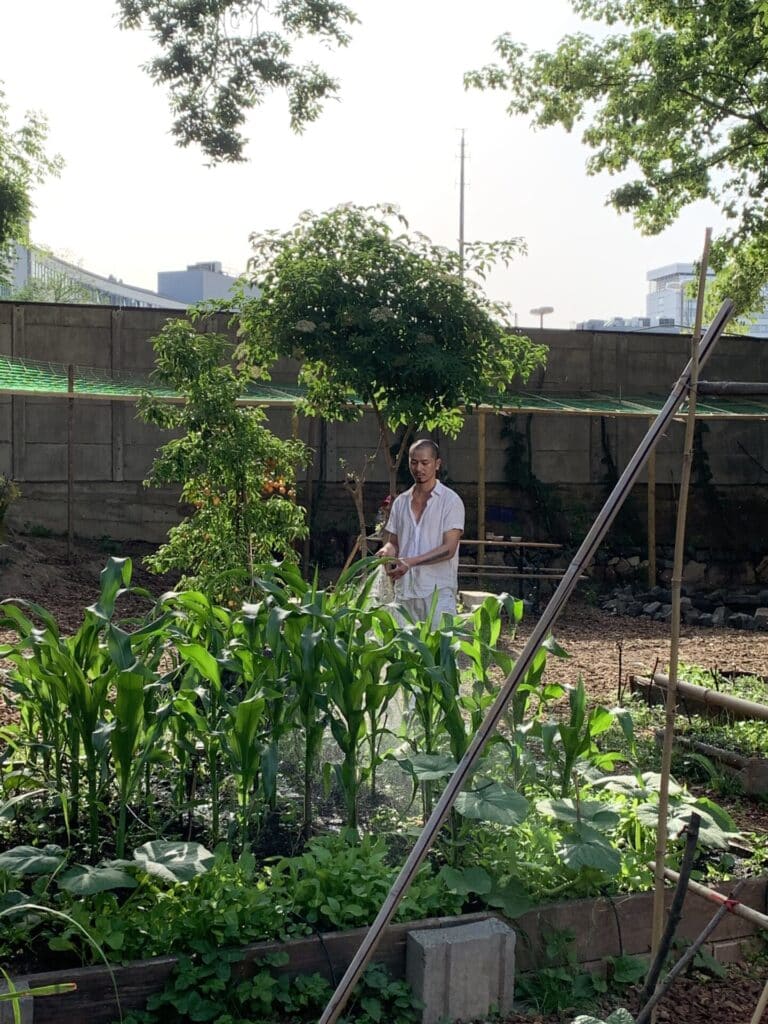
(1) The ‘Plant Turn’
Plants are full of deficiencies from a human perspective. Plants are generally divisible, lack biological individuality, and have no sensory organs, are immobile, devoid of any emotions. In contrast, humans retain diverse senses, think freely, move around, become happy and sometimes suffer emotionally. Having such a fragile nature, humans are therefore forced to live in constant fear[2]. Animals, including humans, must constantly confront the outside world, which is almost entirely unknown, whereas plants can basically stay in their place, adapting to their environment even in the face of difficulties. Even if they are temporarily dying, they can be revived again from the wreckage of themselves.[3] Here, after recognizing the fragility of the vulnerability of its animal system, I would like to reconsider its relationship with humans/plants.
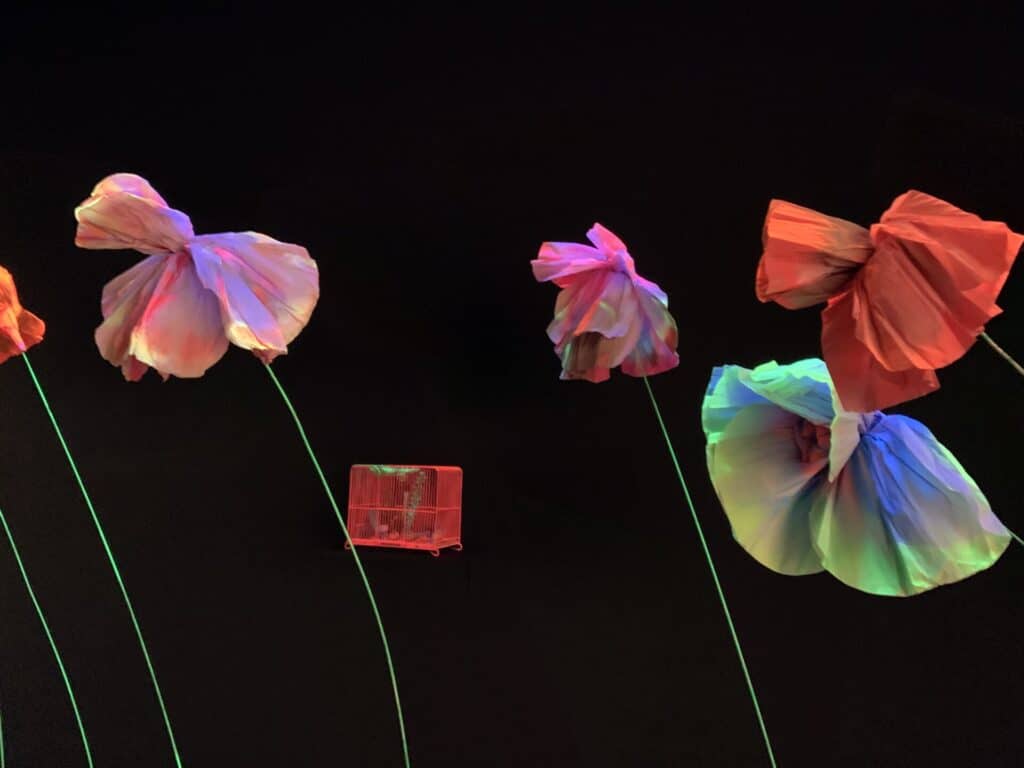
Luminescent flowers create an unusual presence at Arsenal: Perhapes Kudo, who moved to Paris in 1962, felt that in an era of rapid scientific and technological development, magical elements were lost in everyday life. I felt like I had caught a glimpse of plants being dyed by human desire in the installation of plants coloured in unnatural fluorescent colors,
In recent years, in the fields of humanities and anthropology, Animal Studies, including Dana Haraway’s ‘Companion Species’ described in the part 1 and 2, have developed rapidly, and the term ‘The Animal Turn’ in anthropology has been used. More recently, the term ‘The Plant Turn’ has emerged in the context of the Animal Turn, as there has been a lack of interest in the human-plant relationship compared to the human-animal relationship. [4]
However, can we regard ‘plants’ in the same context as ‘animals’? The French philosopher Florence Burgat points out that this question overlaps with my sense. In “Qu’est-ce qu’une plante?”, which is described from the standpoint of animal life phenomenology and animal rights theory, Burgat analytically criticizes the Italian plant physiologist Stefano Mancuso and others who make claims about the ‘anthropomorphisation of plants’, ‘plant rights theory’, ‘plant-centrism’. In my understanding, plants are ‘essential elements’ to animals, and the anthropomorphisation of plants and arguments for plant rights subjectivity can lead to ‘equating’ them with the different subjects. In other words, it may mislead readers to deny recognizing two different livings beings, or depriving plants of a perspective of their own.
Given these different principles of ‘survival’ as life, rather than as opposing entities, how do they coexist in structural chaos, and how do they find balance in a pluralistic way? In other words, it is important to think about how to build a ‘Convivial Relationship between plants and animals’ described in the 2nd report.
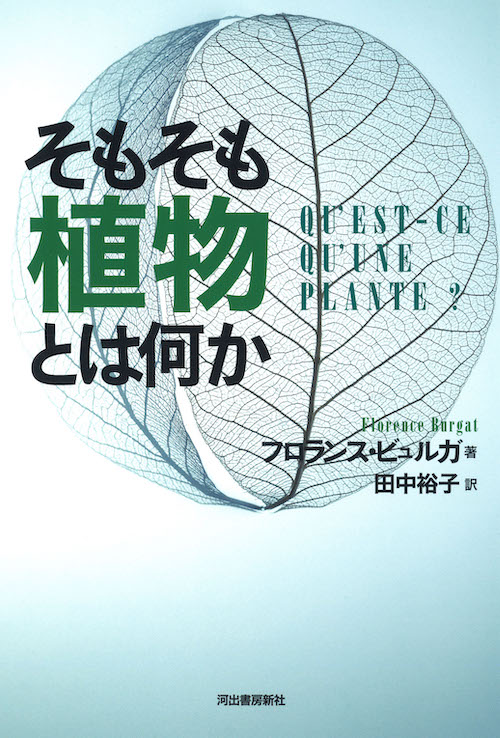
(2) The Undermined Existence of Plants, and the Reversed World
In the Western world, as in the biological pyramid in the Book of Wisdom by Charles De Bovelles (1479-1567) in the late 1400s, humans are at the top as ‘Intelligent’ and plants have continued to be at the bottom [5]. As Macuso notes, this point needs to be re-reviewed.

Mancuso states that “plants dominate every environment on Earth and account for 99% of all multicellular life on the planet.” Also, he mentioned that “plants account for at least 80% of the total weight of all life on Earth[6] ” and that “animals, including humans, account for only a small proportion compared to plants[7] “. In fact, animals including humans almost exclusively rely on plants through air, food, energy, clothing, shelter, etc. [8]
Atmosphere and food need no explanation, but for energy, for example, as the Russian botanist Kliment Timiryazev (1843-1920) said, “Plants are the link between the earth and the sun[9]“, most fossil fuels such as coal, oil and natural gas fuels are the result of solar energy stored deep in the earth, and plants are the mediators. Based on the above, humans would not exist at all without plants.
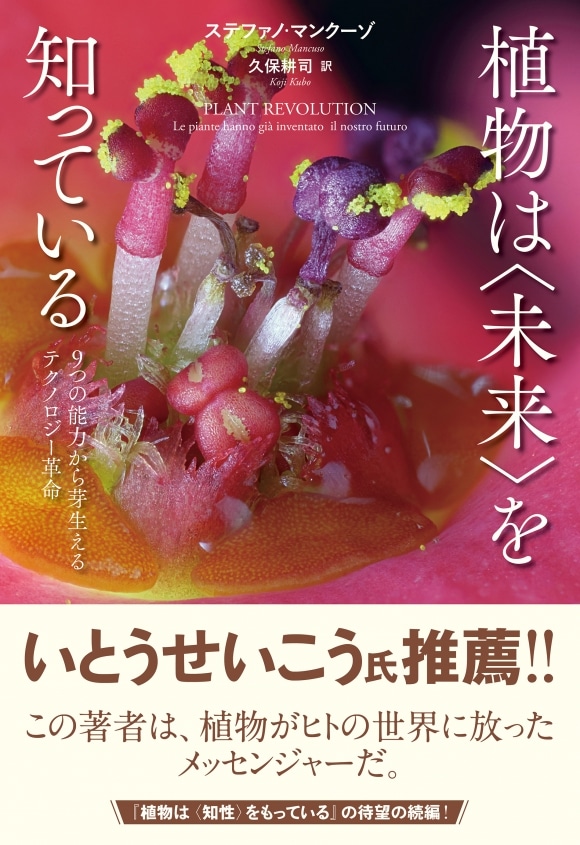
In the Biennial, the Nigerian-American Precious Okoyomon deconstructs the human into soil and assembles an invisible world from the perspective of nature. From a natural perspective, are humans and soil almost the same being?

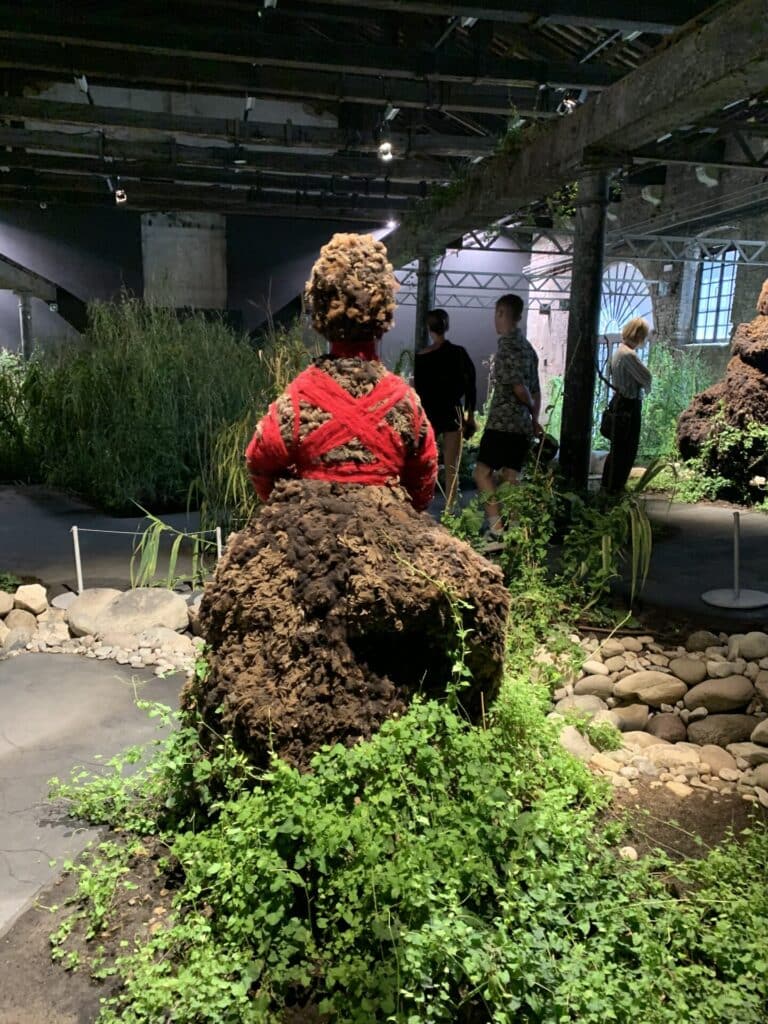
In addition, a Chinese artist, Zheng Bo, ha continuously presenting works on the reproductive activities of plants and humans. When I saw his film work, it reminded me of the false copulation between orchids and bees. The orchid, Ophrys, has a floral form reminiscent of bee mimicry, and the male bee, recognising the floral form as a female bee. So, the bee flies to the orchid, where the male bee shakes itself. As a result, the Ophrys acquire pollen through this false mating.
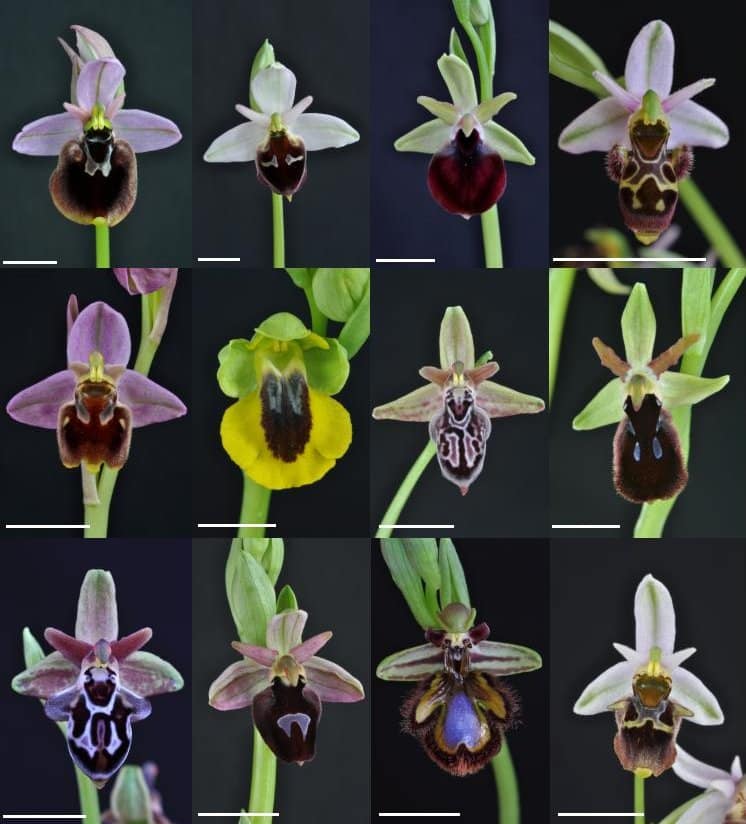
Source.https://orchid1234.exblog.jp/19755955/
In Bo’s film work, humans are shaking their bodies against fern-like plants (which are undisguised). Might this work show an ironic critique of humans’ declining ability to survive by being misled by plants? However, given the ecology of Ophrys, the film does not have any intention to deny the existence of humans being attracted to the Ophrys in the film, but rather reaffirming the need for equalization between humans and plants.
In fact, in the middle of the film, the views are upside down where the human figure is depicted smaller, and the presence of plants is further emphasized, like the humans are ‘immersed’ in the plants. This may signify a switch in perspective from animal to plant, and an attempt to fairly present the pluralistic viewpoints of humans and plants.

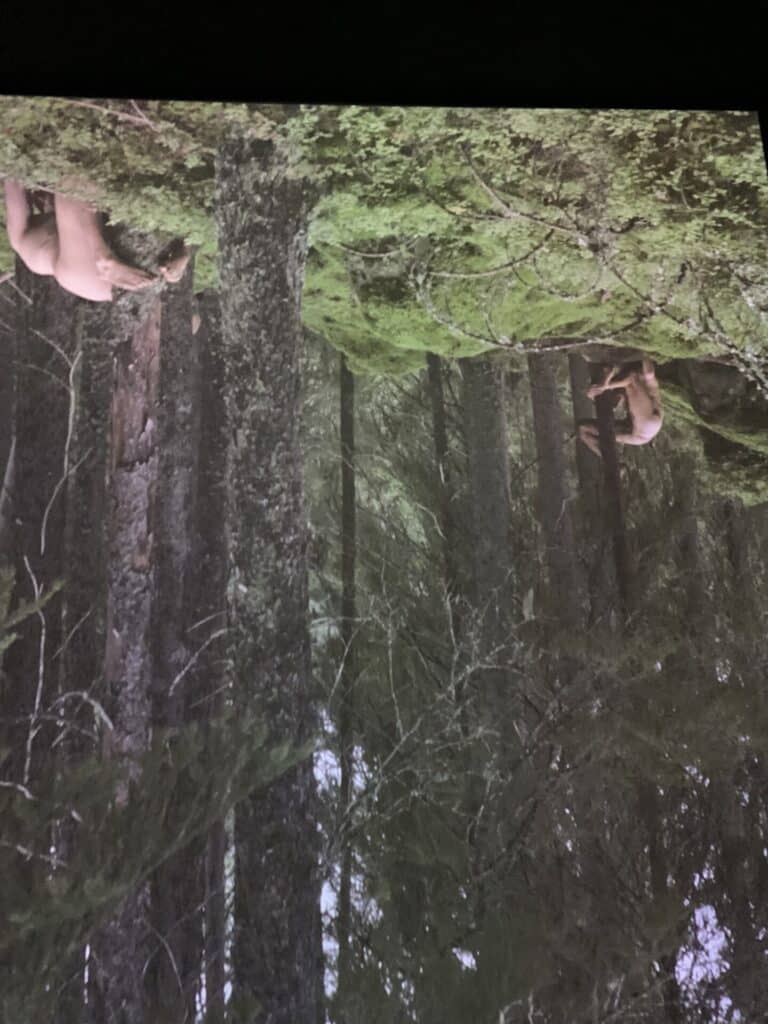
Zheng Bo, drawing on insights from experts in biology, botany and other fields, is attempting to pave an alternative path on the entanglement with life, whether human or plant. In a Swedish forest, five male dancers communed with plants (ferns), provocatively and sensually demonstrating a new relationship between humans and plants.
(3) Plants Linking Environment and Space
Plants correspond to just the capillary part of the circulatory pathway between the sky and the earth, with the sun as the heart.[10]
–Shigeo Miki, The World of the Unborn Child.
Philosopher Emanuele Coccia, in his famous book ‘The Life of Plants: A Metaphysics of Mixture , in claiming that plants are “beings that connect environments and spaces with each other”, describes them with the word, ‘immerse’ which has fundamentally different principles from the others livings[11]. “In other words, the branches and leaves of plants are immersed in the sun, and while using the power of sunlight as a medium, they provide air and food to animals and humans, and support “life that exists in the air.” . [12]
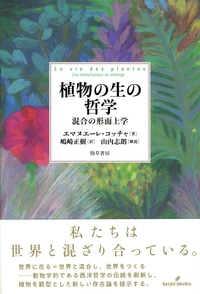
In Documenta, an installation by Vietnamese artist Nguyen Trinh Thi was set up in a pitch-black place in Rondell, a former torture room, reminiscent of an underground space. As you walk into the subterranean space, a large shadow of a plant appears. When you look closely, light is projected onto the plant from the central part of the space, reminding us that the plant is indeed the incarnation of the sun.
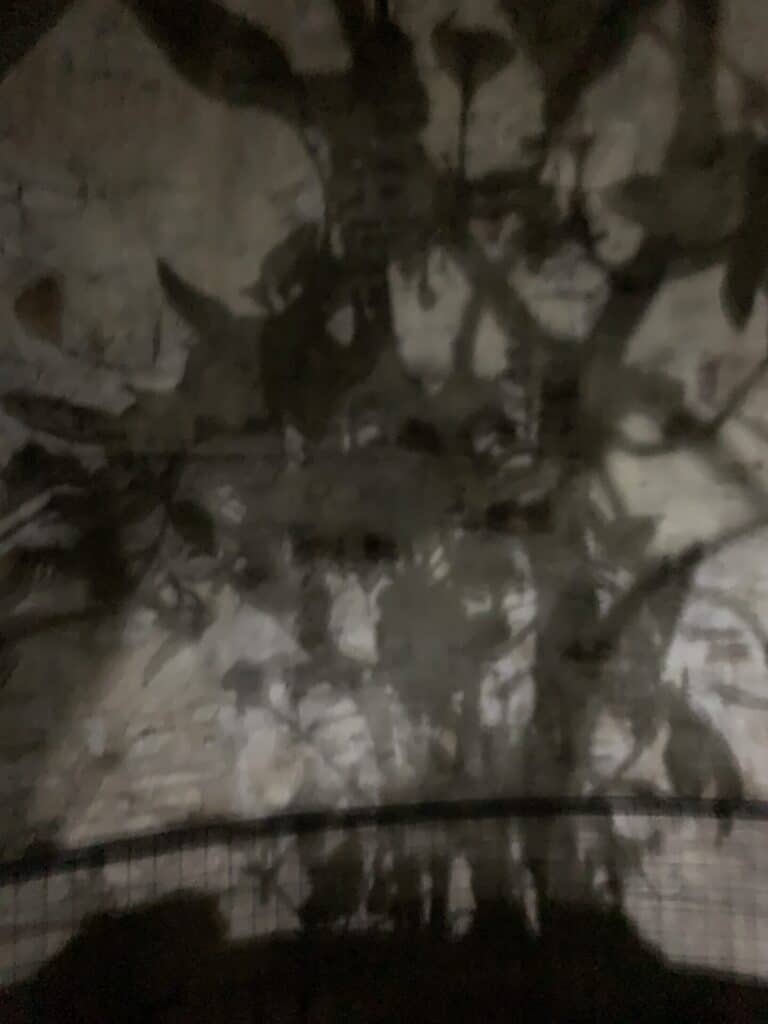
As the visitor enters Rondell’s pitch-dark, cave-like space, plant shadows are projected onto the ceiling and walls of the circular building. The shadows of giant plants are projected in the underground world, capturing the viewer’s movements.
On the other hand, looking from the hollow to the underground world, plant roots and their networks provide information and air to micro-organisms and other creatures, even in the invisible soil. As is clear from the movement of plant rhizomes and rhizobium, etc., they possess ’emergent properties (properties that emerge as a whole when multiple elements influence each other[13] )’ like the modern internet, social networks, etc., and create a huge network underground.
Trees and roots that have spent an immense amount of time in an area, with their roots majestically growing in the area, become deeply connected to the history and landscape of the land. They have been the object of worship all over the world as beings that transcend time and space. For example, in my hometown, the deity of the Kumano Hongu Taisha Grand Shrine, “Ketsumikonokami is said to be the ‘son of the tree’[14], and is identified with Susanowo, the ‘God of the Land’s Roots (the Underworld)’[15]. Plants support not only the hollow, but also the underground world of soil and ‘underworldly life’ such as invisible souls. [16]
In this way, plants have the effect of infiltrating each other through the composition of the atmosphere, photosynthesis, root networks, etc., while being mutually internalized in different environments and spaces such as “hollow and soil”, and time “past and present” [17] ]. Based on these plant characteristics, as Coccia states, “plants have set an ocean where no ocean exists”[18], plants have indeed brought the concept of an ‘ocean’ to the land and created a ‘foundation of life (a fundamental place[19] )’ in which humans and plants, life and death, self and others, etc. are all immersed.
2 Plants Linking Humans and Nature
(1) Between Animals and Plants.
The first person who comes to mind when thinking of people who have speculated on the relationship between plants and animals is Minakata Kumagusu, a Japanese biologist from the Kinan region. He coincidentally has both ‘bear’ for animals and ‘camphor’ for plants in his name in Japanese. Kumagusu’s deepest interest was in ‘Physarum’ (slime molds). Today, slime molds are at the forefront of life research, and the correctness of Kumagusu’s intuition is widely acknowledged[20]. This is because slime fungi are in the border region between animals and plants[21], that is, they are ambivalent beings that are ‘both animal and plant’, and provide many hints for thinking about the primordial forms of life, and the relationship between nature and humans.
The anatomist Shigeo Miki (1925-1987)’s research shows a deeper connection with Kumagusu’s study. Miki wrote: “The body of a plant is the intestinal tract of an animal pulled out and turned inside out. The root hairs become exposed to the internal villi, opening the body to the atmosphere and the earth, which interact with each other perfectly.[22] ” As he stated, the human body and plant roots are connected. In this regard, the American geologist David R. Montgomery also states that “plant roots and the human colon have the same function and there are no boundaries here”[23]. In this sense, from a human perspective, plants may be regarded as “part of the biological body (and vice versa)”. This aligns with the concept of ‘external organs[24]‘ as described by Japanese anthropologist Toshiaki Ishikura. In other words, through food, the internal organs in the body are opened like a tube through the mouth and anus, and are connected to the world outside the body through the roots of plants.[25] The notion of ‘external organs’ can arise when the visceral experience of humans transcends the skin and connects with the outside environment.
In this respect, Brazilian artist Rosana Paulino explores the relationship between plants and humans. Although her work focuses on negative aspects of human history such as colonialism, slavery and discrimination against women, the subjects depicted are ambivalent beings (beings that are both plants and animals), and her work may present a new kind of relationship between plants and humans. The ‘roots’ and ‘leaves’ extending from this existence may resonate with the words of Miki and Ishikura.
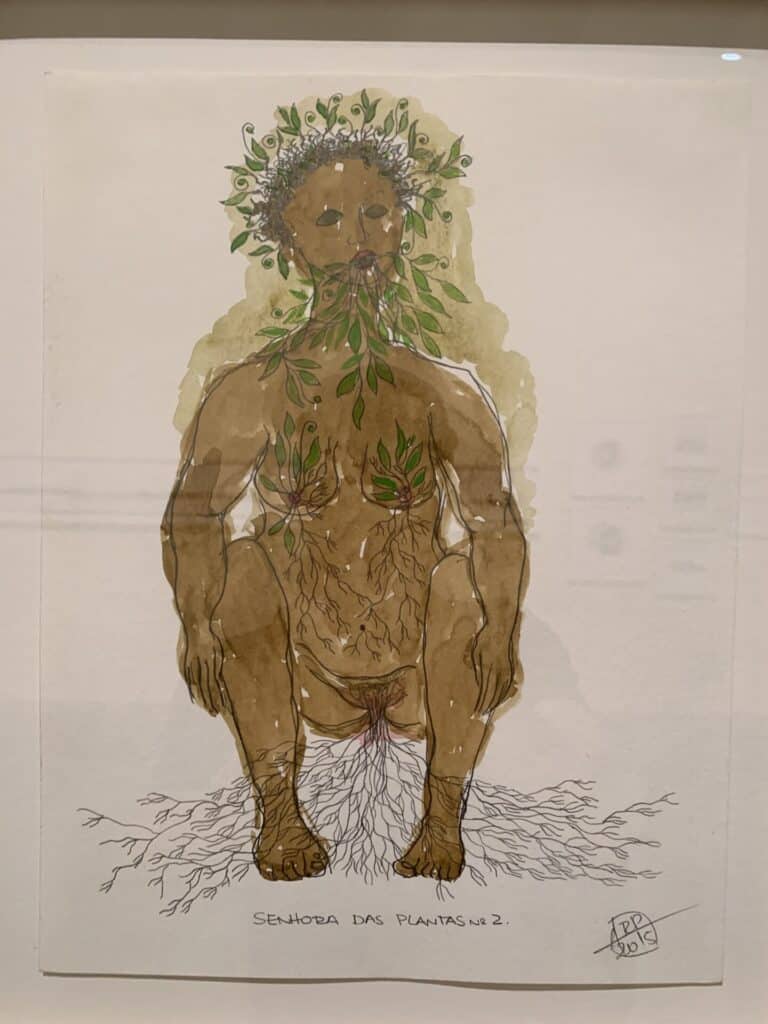
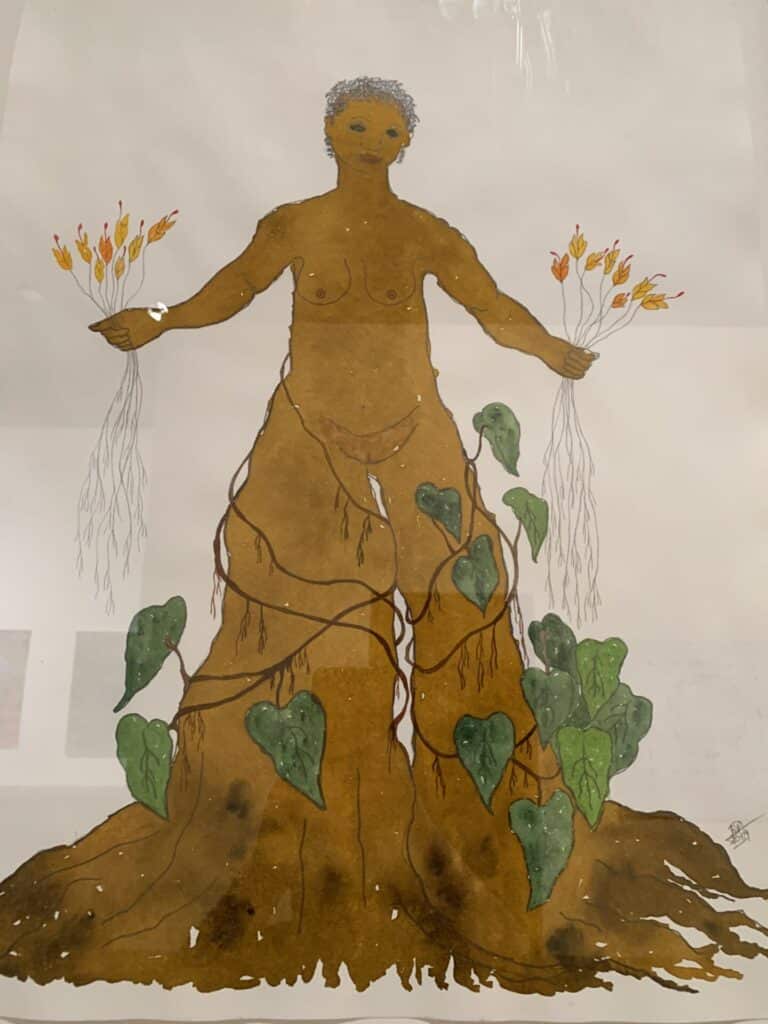
A striking drawing of roots spreading from a woman’s body. Criticising colonialism and slavery in Brazil, Rosana juxtaposes the existence of plants with black slave women of the past who breastfeed their masters’ children. She raises the question: are humans plants or are plants humans?
(2) And to the Source (Root)
The forests, which have not been axed for a thousand and a half years, have become so intricately intertwined with each other and the plants and trees that they are nowadays referred to as “ecology”.
Specialist disciplines have even emerged to study this interrelationship.[26]
–Kumagusu Minakata (letter to Takeji Kawamura, 19 November 1911).
Kumagusu’s words also influence the Mikan/Orange Collective’s philosophy. Kumagusu emphasized not only individual lives, but also the intertwined relationships of life, including place and space, from plant to plant, the influence between animal to plant, and plant to inorganic objects, etc.
We also aim to clearly distinguish ourselves from the fashionable ‘ecology’ such as anthropomorphism of plants and the theory of plant rights, and for our work to be oriented towards a more fundamental movement than progress, as in Kumagusu’s thought. In other words, Kumagusu’s ‘ecology’ is a rhizome-like movement which is a chaotic, degenerative, that spreads from a dim root outwards, horizontally, unlike a ‘tree’ movement growing vertically, only aiming at the tip or towards progress.[27] The Kinan/Kumano region of Wakayama, Kumagusu’s hometown, where he was influenced is also known in Japanese mythology as the “Root of Katasunokuni (underworld). The region of Kinan/Kumano in Wakayama Prefecture, where Kumagusu’s ideas were born, is said to be the ‘root of the root’ in Japanese mythology, and being such, is an extremely important place.
The ‘root’ is said to be the plant that controls ‘intelligence’, as described by Plato (427-347 BC) and Mancuso. It is also said to be the ideological important part, in the concept of the rhizome in the writings of Gilles Deleuze & Félix Guattari discrivs[28]. For roots, the French philosopher Simone Weil (1909-1943) (who died in her early age), is described as ‘having roots’. ‘Having roots is the most spiritually important for human soul as well as the most neglected demand‘ she said, in her book ‘The Need for Roots’.[29] Continuing to grow a single taproot like Racines and lateral root Radicelle to the radical, there is a risk of cutting off healthy branches and roots and creating an exclusive fundamental social structure. In Moden times, radical ideas have contributed to genocide, such as ethnic cleansing in the Nazi Holocaust and the Yugoslav conflict. On the other hand, in the post-modern world, which tends to eradicate roots compared to the modern period which emphasizes the importance of growing taproots. As a result, we are faced with the problem of global homogenisation and standardization due to globalization and economic colonialism.
In this context, the French curator Nicolas Bourriaud, has created the concept of ‘Radicant Art[30] ‘. ‘Radicant’ refers to an organic movement that does not, as in Kumagusu’s thought, emphasize the extension of the taproots or lateral roots, but rather the extension of lateral or whisker roots on the network(The difference with ‘rhizome’ is that it acknowledges the existence of ‘subject-object’ from the perspective of dealing with art, in my opinion). In other words, being radicant is a movement that tries to re-extend its own roots in different contexts or formats. For example, in humans, it is the movement of migrants, exiles and urban wanderers, and in plants, it is the movement of veins, like Ivy, which does not stick to its main root but extends its roots in all directions from the surface it touches.[31] Briault sees here the possibility of transcending modernity and post-modernity.
Even though ‘’having roots is neglected’, as Weil stated, Mexican artist Felipe Baeza intuitively seems to create pictorial expressions depicting something like the roots of radicant by floating through new places and time and space, intuitively and continuously extending and reestablish his roots, like a radicant plant.
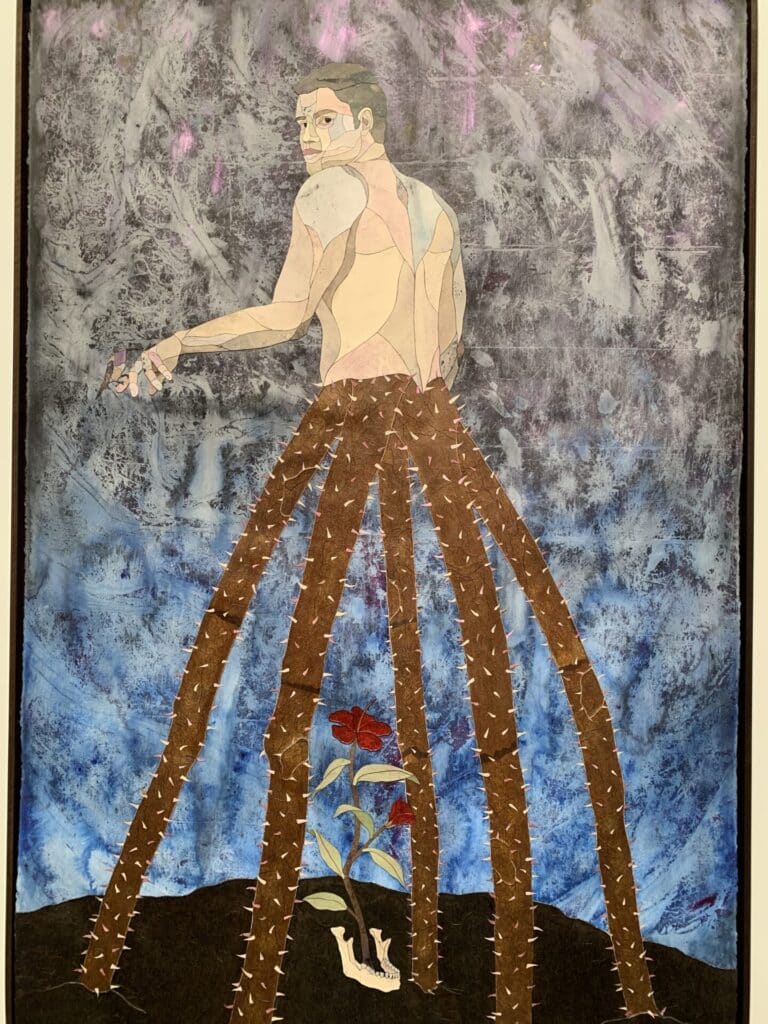
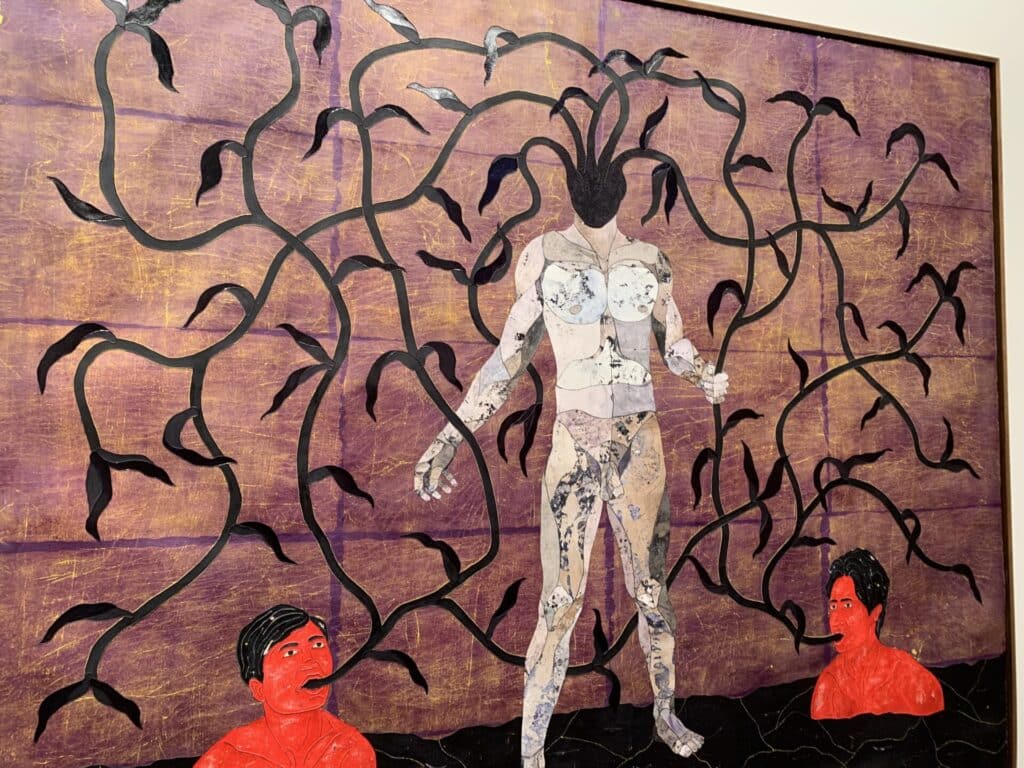
Roots and vines grow from the half-human, half-plant entity. This is drawn from Baeza’s experience of migration from Mexico to the USA. It is a self-portrait of himself, drawing on his experience of fleeing the world and putting down new roots, like Ivy, Boots and other radicant plants.
Also, in the context of Radicant, both at the Biennale and at Documenta, The Nhao Nguyen Phan, introduced in 1st part, and the aforementioned Nguyen Trinh Thi, introduced in the 2nd part, were prominent Vietnamese artists. This was no doubt influenced by the complex history in the colonies, and by the Vietnam War (1955-1975) and the diaspora (migrants, colonisers, refugees, etc.) that resulted from it. For example, at the Berlin Biennale for Contemporary Art [32], which I visited after Documenta, the video works of Tuan Andrew Nguyen and Thuy-Han Nguyen-Chi’s video installation shone powerfully.
Tuan Andrew Nguyen who immigrated to the US as a refugee from Vietnam, works primarily with the history and memory of war. At the Hamburger Bahnhof, one of the Berlin Biennale’s venues, a video work produced in collaboration with the Vietnamese-Senegalese community shows the aftermath of a complex history from the French colonial period to the Vietnam War, with the people living there gradually attempting to repair the soul that Veilleux describes by putting their roots down.
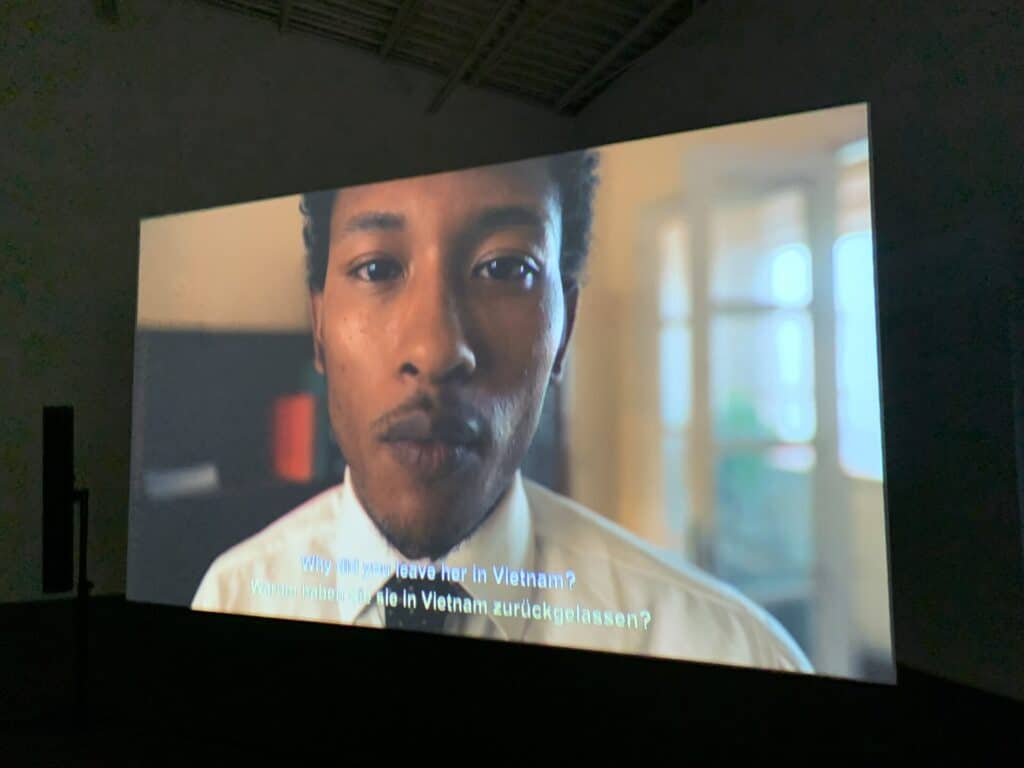
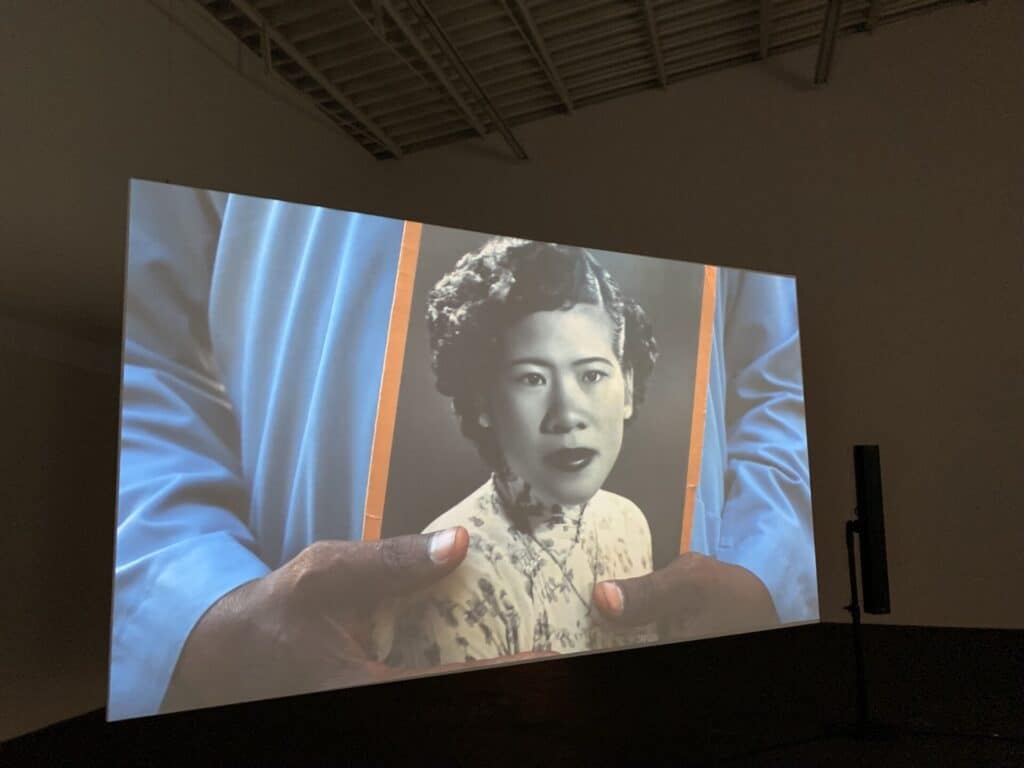
Chui Hanh Nguyen Chi’s blue-tinted images and spaces also slowly unfold a story, interweaving fragments of a woman’s voyage by boat from Vietnam to Thailand and then to Germany after the Vietnam War. In this film, we catch a glimpse of Edouard Glissant (1928-2011), who is often referred to with the term ‘creole art’, which Briault often uses to describe Radical art. ‘Creole’ was an adjective used during colonialism to mean ‘colonial-born’, and nowadays anyone born in a colony, regardless of race, is sometimes referred to as a `Creole’. In a ship installation reminiscent of Glissant’s ‘The Open Ship[33]‘, the history of Vietnamese refugees floating in the sea after being released from a dangerous situation on a ship in the South China Sea overlaps and echoes with the history of Creoles in the past. In this way, it is becoming even more important to think about ‘how to capture the roots’.
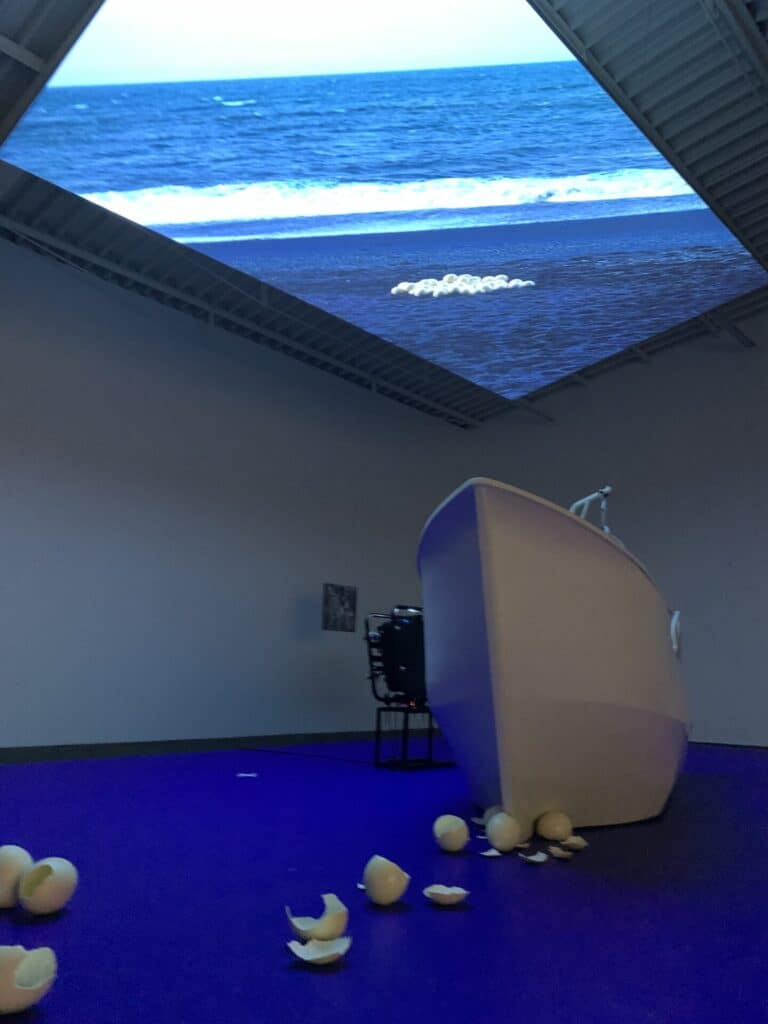
Sea turtle eggs and ship installations, the images of which emitted a blue light, were extremely beautiful. The blue-coloured space with the slow-moving images was just like looking up at the blue sky from the top of an ‘open ship’ in the ocean.
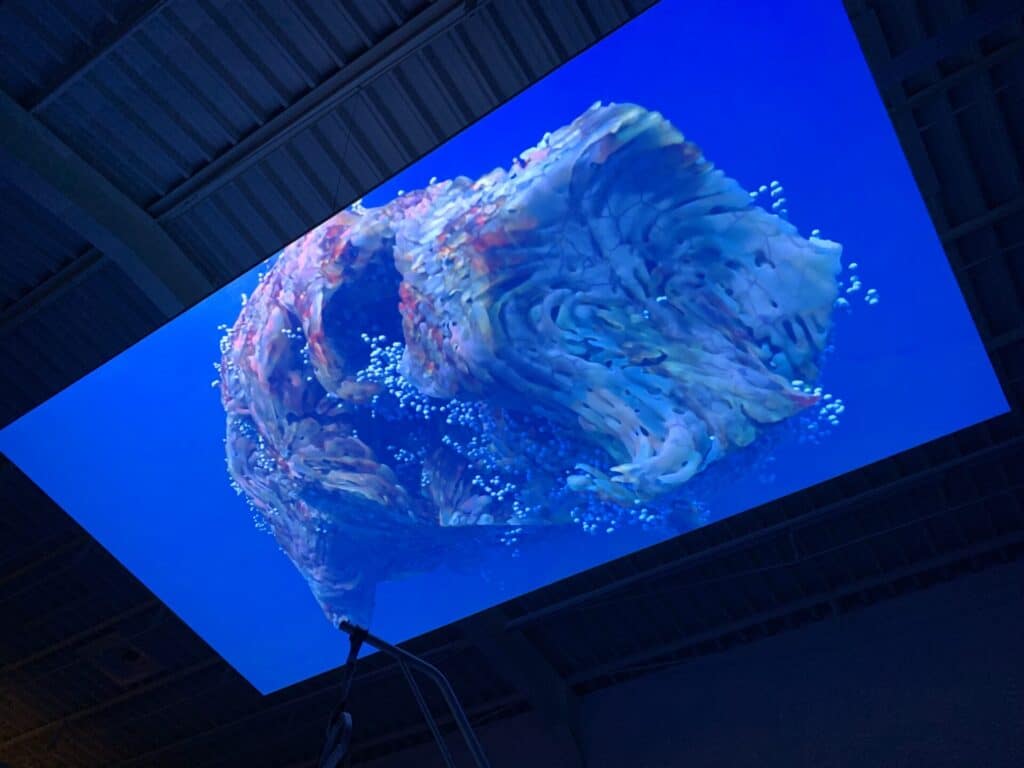
3 Towards the Mikan/Orange Collective Exhibition
-I think that experimentation and practice in art is a process of going back and forth between two opposing poles: uncertainty and absoluteness, good and evil, right and wrong, winning and losing. *snip* I believe that the world is not one, but consists of multiple worlds with different personalities. They are never merged, but are connected while maintaining their own individualities.[34] –
-We want to put the human, animal and plant worlds on equal footing. That way the orange tree can enjoy the experience of having a home of its own.[35] –
–Satoshi Hirose
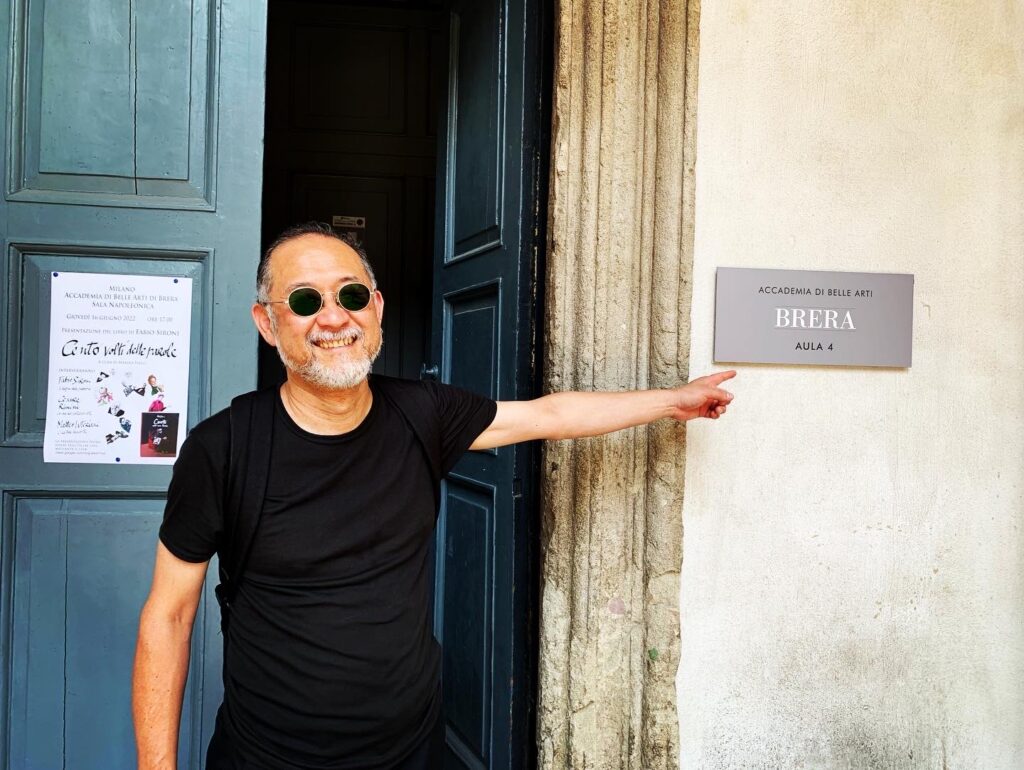
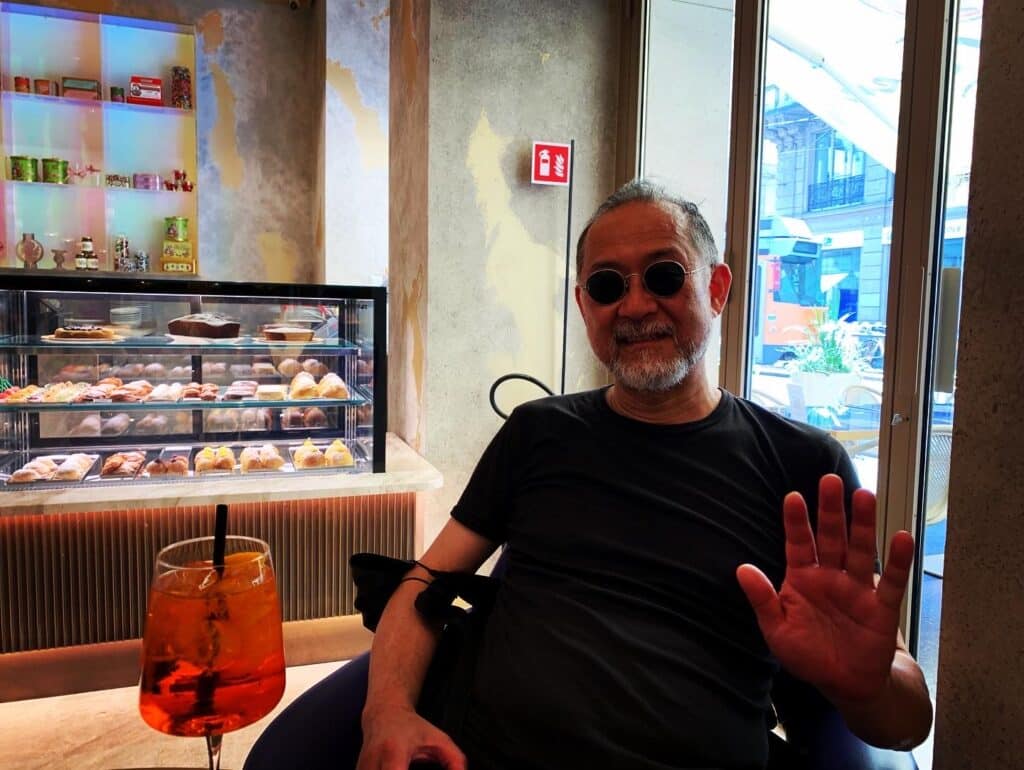
Based on the discussions at the Biennale and Documenta, I will conclude by describing the future exhibitions and activities of the Mikan/Orange Collective. The artist who has been commissioned to produce and exhibit works is Hirose Satoshi (1963-), who goes beyond anthropocentrism and aims for a convivial coexistence of incompatible ambiguities.
Hirose is also a ‘Radicant‘ artist who embodies the very idea of ‘movement and continuity[36] ‘. Hirose moved to Italy in 1991, and continued to put down roots in Italy as a Japanese while maintaining the irreconcilable ‘cultural ambivalence between Italy and Japan to express his artistic practices.[37] He tries to allow ambivalent things to coexist in a pluralistic way while polar opposites such as ‘visible/invisible’, ‘animal/plant’, ‘natural/artificial’ coexist. For example, modern society places importance on what can be seen through the sense of sight, while Hirose places importance on appealing to the senses of touch, taste and smell in everyday life. During my stay in Milan, I was allowed to stay in Hirose’s studio, where natural and artificial citrus fruits were randomly placed in his art studio. Touching and smelling them, I once again experienced the rich aroma of natural objects and their weight, which cannot be captured visually. As can be seen from Hirose’s commitment to food, he appeals not only to the sense of sight, but also to the senses of smell and taste, and tries to put these senses on an equal footing.
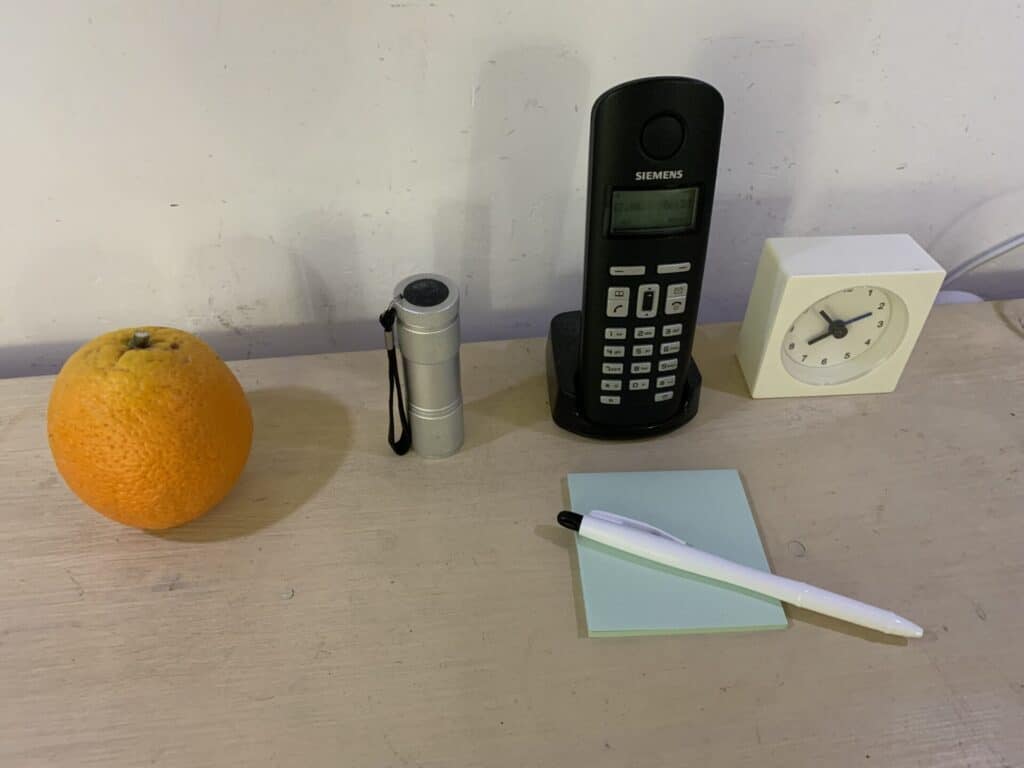
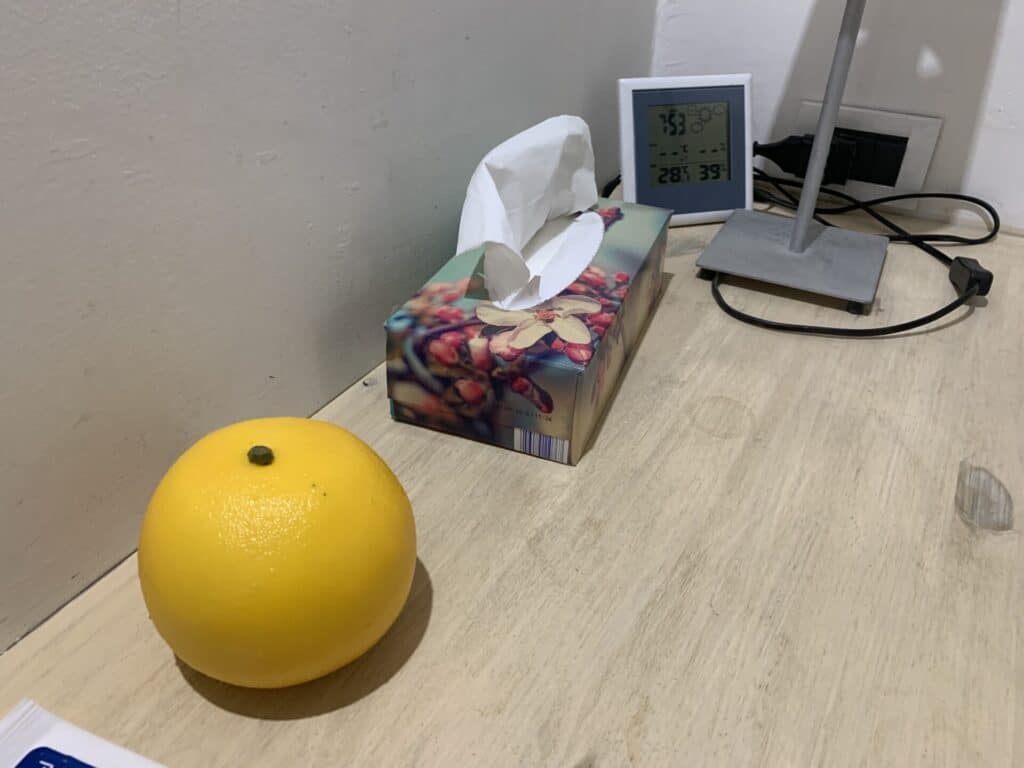
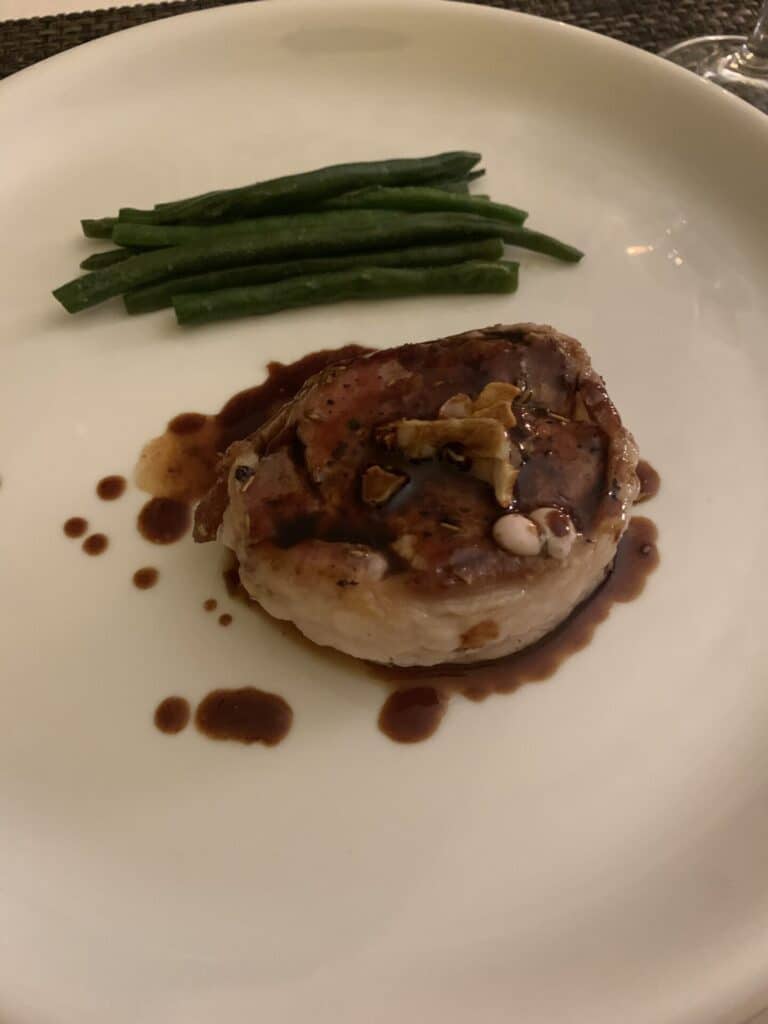
Additionally, plants, as we have mentioned, are also opposite from human beings in terms of basic survival principles, yet they have the ability to ‘connect environments and spaces’, and continue to function in chaos[38]. Furthermore, despite their lack of cognition and sensory organs, plants compose colonies–groups formed by individuals of the same species of organisms, aggregates that behave in an organized manner.[39] Hirose has recognised this, and through his works in Chiang Mai, Thailand, such as Spice Room (1995) and House of Orange Trees (Casa Del albero di arancia, 2006), he has been trying to make us reconsider the relationship between plants, and between humans and plants.
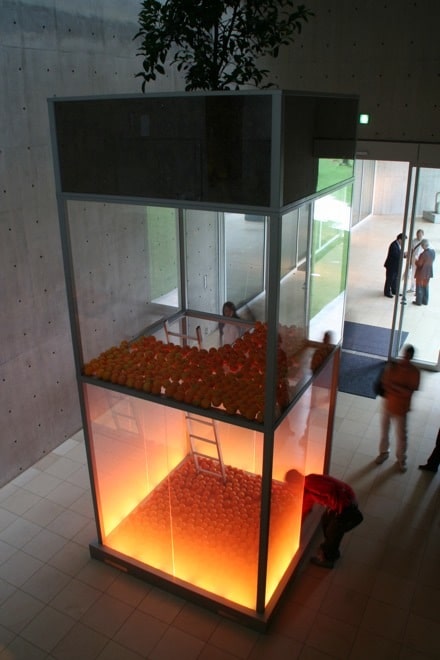
Source: Tomio Koyama Gallery (http://tomiokoyamagallery.com/artists/satoshi-hirose/)
It is a place (home) for oranges, filled with the scent of oranges.
Through the concept of ‘inside/outside’ in a house or room, he created a device that allows people and plants to have a mutual experience of the perspectives of each other. This may provide the viewer with a perspective that is directly connected to the aforementioned discussion of mutual immanence.
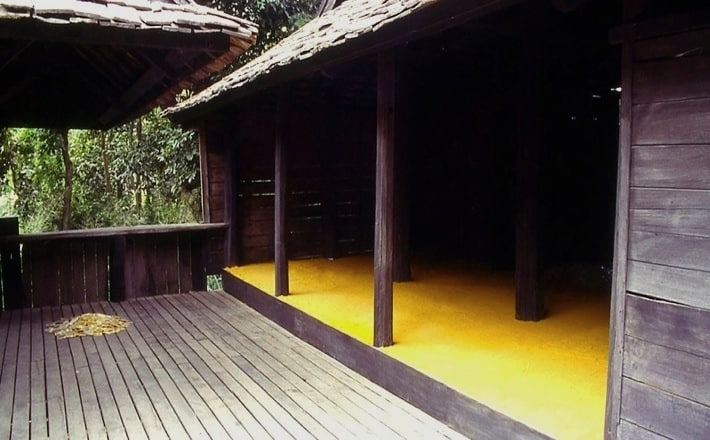
Source: Satoshi Hirose website
(https://www.milleprato.com/works_detail.php?id=45&category_id=0&pageID=5)
This installation was created by Hirose’s residency in Chiang Mai. Curry powder was rolled on traditional stilt houses, creating a ‘place’ for spices. In an environment dyed yellow, which is an important color in Hinayana Buddhism, the boundary between animal and plant becomes blurred.
And Hirose’s interest, like Kumagusu’s, comes down to the world of microcosm and macrocosm. Kumagusu said that the microcosm of bacteria seen through a microscope and the macrocosm of the macrocosm are identical and can all be reduced to ‘Dainichi Buddha‘[40]. As far as Hirose’s lemon project, Beans Cosmos and other expressions are concerned, Hirose discovers the universe in small lemons and beans.
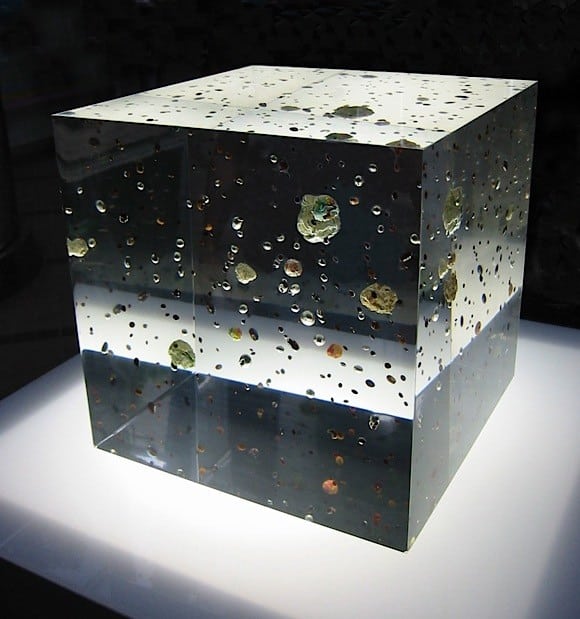
Source: Satoshi Hirose website.
(https://www.milleprato.com/works_detail.php?id=46&category_id=1&pageID=3)
In other words, like Kumagusu, Hirose is also thinking about the root (origins) that lie in the intricate chaos, and pursuing “something” that unites the contradictory nature, life, body and spirit at the opposite ends of the spectrum. The genealogy of Kumagusu’s thought and practice, created by this place called Kumano, the ‘Land of Roots’, exists within us, transcending time and space. Our future practice of Mikan/Orange Collective based on them should be able to raise important questions about ecology aiming for only the ‘cutting edge’ in current trends, including exploring the value and meaning of fruit in our society.
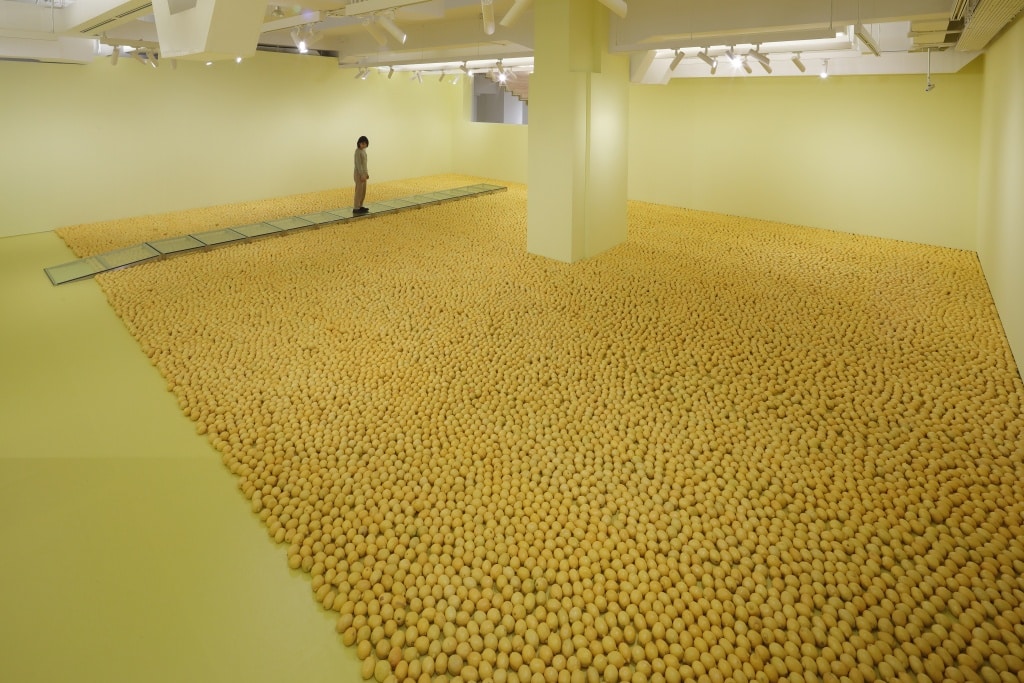
Source: Tomio Koyama Gallery (http://tomiokoyamagallery.com/artists/satoshi-hirose/)
As mentioned in ‘Orange Collective: From Mikan and Spiritual Tradition in the East, to Orange in the Global Market’, we will de-centre ‘human’ and ‘art’, reposition ‘people’, ‘plants’, ‘oranges’, ‘agriculture’, ‘professionals’, ‘institutions’ and ‘art’ as equal relations, and here in Kinan/Kumano, re-create a ‘fundamental place’ in which they are mixed. Based on the Biennale and Documenta, we would like to move forward at our own pace, confident that our activities and exhibitions will take on even greater significance in the world in the future.
[1] Nakazawa, Shinichi, Baroque in the Forest, Kodansha Academic Library, 2006, p. 275.
[2] Florence Burgat, translated by Yuko Tanaka,Qu’est-ce qu’une plante? , Kawade Shobo, 2021, p. 85.
[3] Ibid, p. 85.
[4] Kondo, Shiaki and Mariko Yoshida (eds.), Eat, Be Eaten, Eat Each Other: Thoughts on Multispecies Ethnography, Seidosha, 2021, p. 44.
[5] Stefano Mancuso and Alessandra Viola, translated by Koji Kubo, Plants have <intelligence>, NHK Publishing, 2015, pp. 32-34.
[6] Stefano Mancuso, translated by Koji Kubo, Plants Know the <Future>: The Technological Revolution that Buds from Nine Capabilities, NHK Publishing, 2018, p. 158.
[7] Stefano Mancuso and Alessandra Viola, translated by Koji Kubo, Plants have <intelligence>, NHK Publishing, 2015, p. 10.
[8] Ibid, pp. 62-68.
[9] Ibid, pp. 65, 66.
[10] Shigeo Miki, The World of the Fetus, Chuko Shinsho, 1983, p. 156.
[11] Emanuele Coccia, translated by Masaki Shimazaki, The Life of PlantsPhilosophy of Plant Life: A Metaphysics of Mixture, Keiso Shobo, 2019, Chapter 3: ‘Root Theory – Celestial Life’.
[12] Toshiaki Ishikura, ‘Journey and Creation over Earth Surface Space – Ethnographic Art as a Trajectory of Life’, in Yuko Hasegawa (ed.), New Ecology and Art: The Humanocene as a Magotsuki Period, Eibunsha, 2022, p. 92.
[13] IS Digital Dictionary, ‘Emergence/emergence characteristics’, https://ipsj-is.jp/isdic/4437/
[14] In the Kii Shoku-fudoki, it is stated that “Kumano Za Shrine in Noboru is Ietsumiko-ojin of the Honkoku Shinmeicho, and Ietsumiko-ojin is another name for Susanoo-no-Mikoto”. This is also supported by the fact that the Kii Shoku-fudoki states: “The Kumano Za-jinja Shrine in Noboru is the Ietsumiko-ojin of the Honkoku Shinmeicho.
[15] According to Kuwabara Yasuhiro, Kumano: Its Surface and Depths, Kamogawa Publishing, 2009, p. 62, not only Susanowo but also kami such as Gojumugami and Kumanokusubi worshipped in Kumano are said to be tree gods or forest gods.
[16] Toshiaki Ishikura, ‘Journey and Creation over Earth Surface Space – Ethnographic Art as a Trajectory of Life’, in Yuko Hasegawa (ed.), New Ecology and Art: The Humanocene as a Magotsuki Period, Eibunsha, 2022, p. 92.
[17] same as above
[18] Emanuele Coccia, translated by Masaki Shimazaki, Philosophy of Plant Life: The Metaphysics of Mixing, Keiso Shobo, 2019.
[19] Taisuke Karasawa, Minakata Kumagusu – The Limits of Japanese Potential, Chuokoron, 2015, from The Great Wonder that Encompasses Everything.
[20] Shinichi Nakazawa, Lemma Studies, Kodansha, 2019, p. 21.
[21] Kazuko Tsurumi, Minakata Kumagusu, 1981, Kodansha Science Library, p. 76.
[22] Emanuele Coccia, translated by Masaki Shimazaki, Philosophy of Plant Life: The Metaphysics of Mixing, Keiso Shobo, 2019, p. 192.
[23] David Montgomery, translated by Natsumi Kataoka, Soil and Internal Organs: The World of Microorganisms, Tsukiji Shokan, 2016, pp. 309, 310.
[24] Toshiaki Ishikura, interviewee Taisuke Karasawa, ‘Anthropology of the external organs and co-mutants’, 2020, EKRITS website.
https://ekrits.jp/2020/12/3980/
[25] Katsumi Okuno, More Than Human: Multispecies Anthropology and Environmental Humanities, Eibunsha, pp. 213-215, 2021.
[26] The Complete Works of Minakata Kumagusu, vol. 7, Heibonsha, 1981, p. 526.
[27] Reiji Ando, Kumagusu Life and Spirituality, Kawade Shobo, 2020, p. 199.
[28] Gilles Deleuze, Félix Guattari, translated by Kunikazu Uno et al, A Thousand Plateaux: Capitalism and Schizophrenia, Kawade Bunko, 2010, pp. 18-25.
[29] Simone Veilleux, translated by Mayumi Tomihara, The Need for Roots, Iwanami Bunko, 2010, p. 64.
[30] Nicolas Briault, translated by Takeda Hironari, The Radicant, Filmart, 2022, pp. 26, 27.
[31] Ibid, pp. 70, 71.
[32] Berlin Biennial website (https://12.berlinbiennale.de/de/)
[33] Edouard Glissant, translated by Keijiro Suga, Poetics of Relation, Inscript, 2000, pp. 11-17.
[34] Satoshi Hirose Book I: Works, 2020, p. 6.
[35] Satoshi Hirose Book II: Essays & Others, 2020, p. 36.
[36] Sumitomo, Fumihiko, ‘Moving and Sustaining — Satoshi Hirose’s Soft Thoughts for Symbiosis’, Satoshi Hirose Book II: Essays & Others, 2020, pp. 6-7.
[37] Satoshi Hirose Book II: Essays & Others, 2020, p. 36.
[38] Florence Burgat, translated by Yuko Tanaka,“Qu’est-ce qu’une plante? , Kawade Shobo, 2021, pp. 116, 120.
[39] Stefano Mancuso, translated by Koji Kubo, Plants Know the <Future>: The Technological Revolution that Buds from Nine Capabilities, NHK Publishing, 2018, pp. 48-53.
[40] Yanagida, Kunio, Minakata Kumagusu, The Collection of Letters of Minakata Kumagusu’s Correspondence, Heibonsha, 1976, p. 300.

